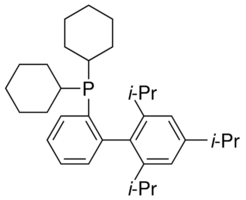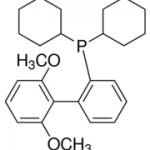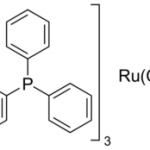2-(Dicyclohexylphosphino)-2′,4′,6′-triisopropylbiphenyl CAS#: 564483-18-7; ChemWhat Code: 66237
Identification
| Product Name | 2-(Dicyclohexylphosphino)-2′,4′,6′-triisopropylbiphenyl |
| IUPAC Name | dicyclohexyl-[2-[2,4,6-tri(propan-2-yl)phenyl]phenyl]phosphane |
| Molecular Structure |  |
| CAS Registry Number | 564483-18-7 |
| MDL Number | MFCD04117682 |
| Synonyms | XPhos, chloro(2-dicyclohexylphosphino-2’,4’,6’-triisopropyl-1,1‘-biphenyl)[2-(2’-amino-1,1‘-biphenyl)]palladium(II), dicyclohexyl(2’,4’,6’‐triisopropyl‐[1,1’‐biphenyl]‐2‐yl)phosphane, (2-dicyclohexylphosphino-2’,4’,6’-triisopropyl-1,1′-biphenyl)[2-(2-aminoethyl)phenyl]palladium(II)chloride, 2-(dicyclohexylphosphino)-3,6-dimethoxy-2′,4′,6′-triisopropyl-1,1′-biphenyl, dicyclohexyl[2′,4′,6′-tris(1-methylethyl)[1,1′-biphenyl]-2-yl]-phosphine, dicyclohexyl [2’,4’,6’-tris(1-methylethyl)[1,1′-biphenyl]-2-yl]phosphine; CAS#: 564483-18-7 |
| Molecular Formula | C33H49P |
| Molecular Weight | 476.716 |
| InChI | InChI=1S/C33H49P/c1-23(2)26-21-30(24(3)4)33(31(22-26)25(5)6)29-19-13-14-20-32(29)34(27-15-9-7-10-16-27)28-17-11-8-12-18-28/h13-14,19-25,27-28H,7-12,15-18H2,1-6H3 |
| InChI Key | UGOMMVLRQDMAQQ-UHFFFAOYSA-N |
| Canonical SMILES | CC(C)c1cc(c(c(c1)C(C)C)c2ccccc2P(C3CCCCC3)C4CCCCC4)C(C)C |
| Patent Information | ||
| Patent ID | Title | Publication Date |
| EP2565182 | NOVEL AMIDE DERIVATIVE AND USE THEREOF AS MEDICINE | 2013 |
| US2015/80628 | CATALYST AND PROCESS FOR THE CO-DIMERIZATION OF ETHYLENE AND PROPYLENE | 2015 |
| US2011/15401 | Metal-Catalyzed Carbon-Fluorine Bond Formation | 2011 |
| EP2062901 | FLUOROBORON COMPOUND HAVING AROMATIC RING OR SALT THEREOF, AND PROCESS FOR PRODUCTION OF COMPOUND HAVING CYCLIC ETHER-FUSED AROMATIC RING BY USING THE SAME | 2009 |
| WO2009/106586 | QUINOLINES AS INHIBITORS OF FARNESYL PYROPHOSPHATE SYNTHASE | 2009 |
Physical Data
| Appearance | White powder |
| Sensitivity | Air Sensitive |
| Melting Point, °C | Solvent (Melting Point) |
| 185.9 | |
| 182 – 184 |
| Description (Association (MCS)) | Partner (Association (MCS)) |
| NMR spectrum of the complex | CuCl |
| Comment (Solubility (MCS)) |
| low solubility in DMF |
Spectra
| Description (NMR Spectroscopy) | Nucleus (NMR Spectroscopy) | Solvents (NMR Spectroscopy) | Temperature (NMR Spectroscopy), °C | Frequency (NMR Spectroscopy), MHz |
| Chemical shifts, Spectrum | 1H | chloroform-d1 | 400 | |
| Chemical shifts, Spectrum | 31P | chloroform-d1 | ||
| Chemical shifts | 31P | chloroform-d1 | ||
| Chemical shifts | 31P | dimethylsulfoxide-d6 | ||
| Chemical shifts, Spectrum | 31P | d(4)-methanol, (2)H8-toluene | 25 | 162 |
| Chemical shifts | 1H | benzene-d6 | 300 | |
| Chemical shifts | 13C | benzene-d6 | 75 | |
| Chemical shifts | 31P | benzene-d6 | 121 |
| Description (IR Spectroscopy) | Solvent (IR Spectroscopy) |
| Bands | dichloromethane |
| Bands | solid |
Route of Synthesis (ROS)

| Conditions | Yield |
| Stage #1: XPhos With sulfuric acid; sulfur trioxide In dichloromethane at 0 – 20℃; for 24h; Cooling with ice; Stage #2: With sodium hydroxide In dichloromethane; water at 0℃; pH=~ 7.0; Cooling with ice; Experimental Procedure To an oven-dried 25 mL round bottom flask equipped with a Teflon-coated magnetic stir bar and rubber septum was added dicyclohexyl-(2′,4′,6′-triisopropyl-biphenyl-2-yl)-phosphane (476 mg, 1.00 mmol) and CH2Cl2 (1.0 mL). The solution was cooled to 0° C. using an ice/water bath and then concentrated H2SO4 (1.00 mL) and fuming sulfuric acid (3.0 mL, 20% SO3) were added dropwise. The solution was allowed to warm to room temperature and stir for 24 h. At this time it was cooled to 0° C. using an ice/water bath and crushed ice (10 g) was added. The solution turned cloudy and white in color. An aqueous solution of NaOH (6.0 M, 20.0 mL) was then added dropwise to the cooled solution until it became neutral (pH 7.0 as judged by pH paper). The aqueous solution was extracted with CH2Cl2 (3×50 mL) and concentrated under reduced pressure to give a beige solid. The crude material was then dissolved in a minimum amount of cold methanol (20 mL), filtered and concentrated (this cycle was repeated) to give sodium 2′-(dicyclohexyl-phosphanyl)-2,6-diisopropyl-biphenyl-4-sulfonate (4) as a beige solid (503 mg, 94%). Mp=>250° C. 1H NMR (400 MHz, CD3OD) δ: 7.52 (s, 2H), 7.46 (m, 1H), 7.22 (m, 2H), 6.90 (m, 1H), 2.24 (m, 1H), 0.71-1.83 (34H). 13C NMR (125 MHz, CD3OD) δ: 148.4, 147.9, 147.8, 147.5, 145.6, 142.8, 137.4, 137.2, 133.92, 133.91, 132.43, 132.42, 129.3, 128.1, 121.3, 121.0, 40.1, 39.9, 39.7, 39.5, 39.3, 38.8, 35.8, 35.7, 32.5, 32.3, 31.9, 30.8, 30.6, 28.7, 28.6, 28.4, 28.3, 27.7, 26.0, 25.9, 23.3, 23.1. 31P NMR (162 MHz, CD3OD) δ: -10.7. IR (neat, cm-1): 3459, 2927, 2851, 1634, 1463, 1447, 1184, 1078, 1040. Anal. Calcd for C30H42NaO3PS: C, 67.14; H, 7.89. Found: C, 66.93; H, 7.77. | 94% |
| Stage #1: XPhos With sulfuric acid In dichloromethane at 0 – 20℃; for 24h; Stage #2: With sodium hydroxide In dichloromethane; water pH=13; | 53% |
Safety and Hazards
| Pictogram(s) |  |
| Signal | Warning |
| GHS Hazard Statements | H302 (18.18%): Harmful if swallowed [Warning Acute toxicity, oral] H315 (72.73%): Causes skin irritation [Warning Skin corrosion/irritation] H319 (72.73%): Causes serious eye irritation [Warning Serious eye damage/eye irritation] H335 (63.64%): May cause respiratory irritation [Warning Specific target organ toxicity, single exposure; Respiratory tract irritation] H413 (27.27%): May cause long lasting harmful effects to aquatic life [Hazardous to the aquatic environment, long-term hazard] Information may vary between notifications depending on impurities, additives, and other factors. |
| Precautionary Statement Codes | P261, P264, P270, P271, P273, P280, P301+P312, P302+P352, P304+P340, P305+P351+P338, P312, P321, P330, P332+P313, P337+P313, P362, P403+P233, P405, and P501 (The corresponding statement to each P-code can be found at the GHS Classification page.) |
Other Data
| Transportation | NONH for all modes of transport |
| Under the room temperature and away from light | |
| HS Code | 293190 |
| Storage | The product will be slowly oxidized in the air, stored for a long time, it needs to be sealed and dried below 0℃ |
| Market Price | USD |
| Druglikeness | |
| Lipinski rules component | |
| Molecular Weight | 476.726 |
| logP | 12.392 |
| HBA | 0 |
| HBD | 0 |
| Matching Lipinski Rules | 3 |
| Veber rules component | |
| Polar Surface Area (PSA) | 13.59 |
| Rotatable Bond (RotB) | 7 |
| Matching Veber Rules | 2 |
| Bioactivity |
| In vitro: Efficacy |
| Quantitative Results |
| pX | Parameter | Value (qual) | Value (quant) | Unit |
| 1 | IC50 | > | 30 | µM |
| Toxicity/Safety Pharmacology |
| Quantitative Results |
| pX | Parameter | Value (qual) | Value (quant) | Unit | Effect |
| 3.82 | inhibition rate(of cell proliferation) | < | 50 | % | antiproliferative agent |
| Use Pattern |
| 2-(Dicyclohexylphosphino)-2′,4′,6′-triisopropylbiphenyl CAS#: 564483-18-7 component of transition-metal catalyst for synthesis of 2H-indazoles |
| 2-(Dicyclohexylphosphino)-2′,4′,6′-triisopropylbiphenyl CAS#: 564483-18-7 as Ligand |
| Palladium-catalyzed Negishi cross coupling between alkyl sulfones and aryl halides is used to prepare functionalized benzyl sulfones. |
| Ligands used in Pd-catalyzed Suzuki coupling reactions to generate Vindoline C-15 analogs. |
| Direct cyclization of 2-haloaniline to Pd-catalyzed indole and tryptophan. [2] Regioregular synthesis of polythiophene. |
| The Sonogashira coupling ligand used in TPGS-750-M is more environmentally friendly. |
Related Chemicals
Buy Reagent | |
| No reagent supplier? | Send quick inquiry to ChemWhat |
| Want to be listed here as a reagent supplier? (Paid service) | Click here to contact ChemWhat |
Approved Manufacturers | |
| Warshel Chemical Ltd | http://www.warshel.com/ |
| Want to be listed as an approved manufacturer (Requires approvement)? | Please download and fill out this form and send back to approved-manufacturers@chemwhat.com |
Other Suppliers | |
| Watson International Limited | Visit Watson Official Website |
Contact Us for Other Help | |
| Contact us for other information or services | Click here to contact ChemWhat |



